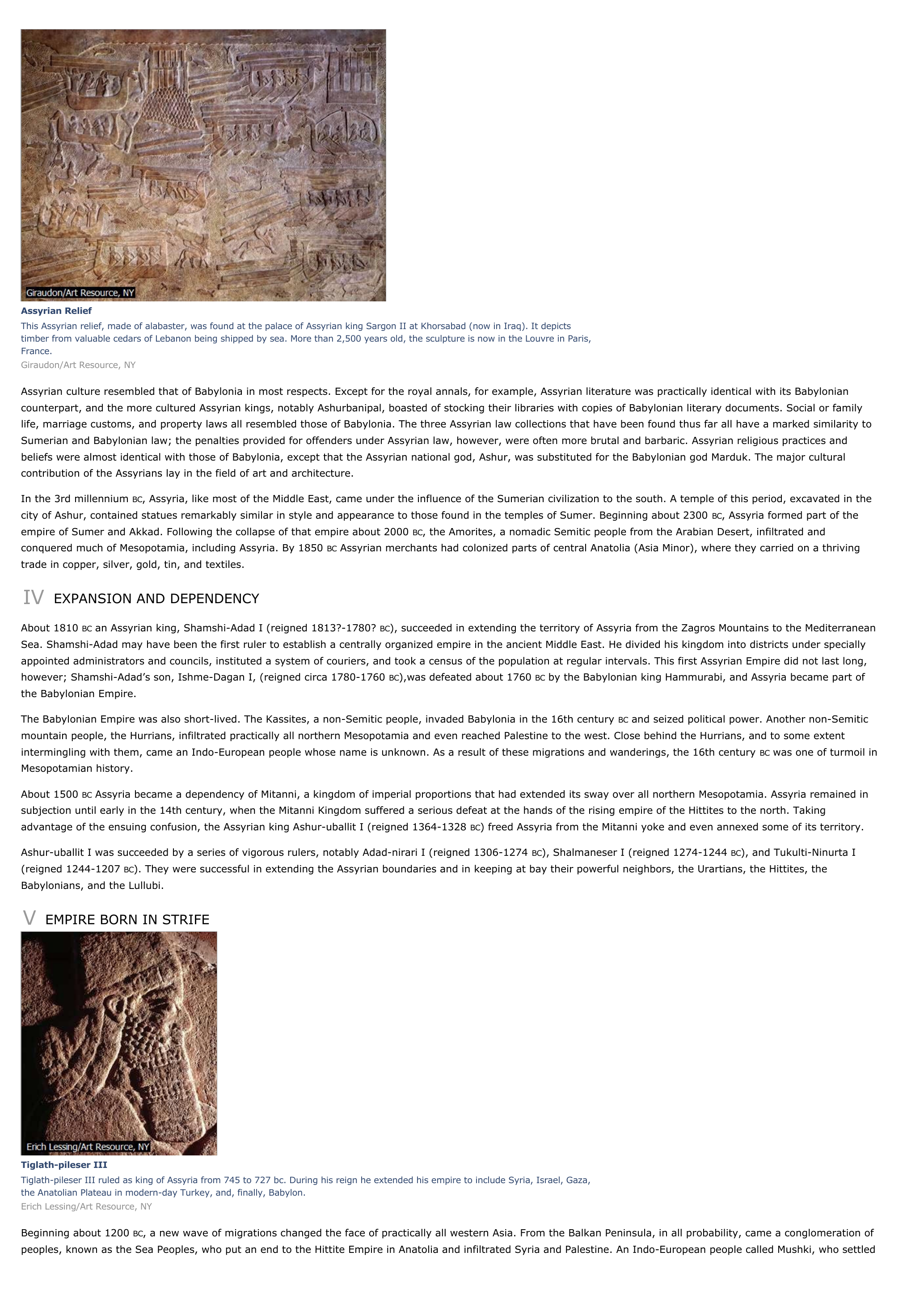Assyria - history.
Publié le 26/05/2013

Extrait du document
«
Assyrian ReliefThis Assyrian relief, made of alabaster, was found at the palace of Assyrian king Sargon II at Khorsabad (now in Iraq).
It depictstimber from valuable cedars of Lebanon being shipped by sea.
More than 2,500 years old, the sculpture is now in the Louvre in Paris,France.Giraudon/Art Resource, NY
Assyrian culture resembled that of Babylonia in most respects.
Except for the royal annals, for example, Assyrian literature was practically identical with its Babyloniancounterpart, and the more cultured Assyrian kings, notably Ashurbanipal, boasted of stocking their libraries with copies of Babylonian literary documents.
Social or familylife, marriage customs, and property laws all resembled those of Babylonia.
The three Assyrian law collections that have been found thus far all have a marked similarity toSumerian and Babylonian law; the penalties provided for offenders under Assyrian law, however, were often more brutal and barbaric.
Assyrian religious practices andbeliefs were almost identical with those of Babylonia, except that the Assyrian national god, Ashur, was substituted for the Babylonian god Marduk.
The major culturalcontribution of the Assyrians lay in the field of art and architecture.
In the 3rd millennium BC, Assyria, like most of the Middle East, came under the influence of the Sumerian civilization to the south.
A temple of this period, excavated in the city of Ashur, contained statues remarkably similar in style and appearance to those found in the temples of Sumer.
Beginning about 2300 BC, Assyria formed part of the empire of Sumer and Akkad.
Following the collapse of that empire about 2000 BC, the Amorites, a nomadic Semitic people from the Arabian Desert, infiltrated and conquered much of Mesopotamia, including Assyria.
By 1850 BC Assyrian merchants had colonized parts of central Anatolia (Asia Minor), where they carried on a thriving trade in copper, silver, gold, tin, and textiles.
IV EXPANSION AND DEPENDENCY
About 1810 BC an Assyrian king, Shamshi-Adad I (reigned 1813?-1780? BC), succeeded in extending the territory of Assyria from the Zagros Mountains to the Mediterranean Sea.
Shamshi-Adad may have been the first ruler to establish a centrally organized empire in the ancient Middle East.
He divided his kingdom into districts under speciallyappointed administrators and councils, instituted a system of couriers, and took a census of the population at regular intervals.
This first Assyrian Empire did not last long,however; Shamshi-Adad’s son, Ishme-Dagan I, (reigned circa 1780-1760 BC),was defeated about 1760 BC by the Babylonian king Hammurabi, and Assyria became part of the Babylonian Empire.
The Babylonian Empire was also short-lived.
The Kassites, a non-Semitic people, invaded Babylonia in the 16th century BC and seized political power.
Another non-Semitic mountain people, the Hurrians, infiltrated practically all northern Mesopotamia and even reached Palestine to the west.
Close behind the Hurrians, and to some extentintermingling with them, came an Indo-European people whose name is unknown.
As a result of these migrations and wanderings, the 16th century BC was one of turmoil in Mesopotamian history.
About 1500 BC Assyria became a dependency of Mitanni, a kingdom of imperial proportions that had extended its sway over all northern Mesopotamia.
Assyria remained in subjection until early in the 14th century, when the Mitanni Kingdom suffered a serious defeat at the hands of the rising empire of the Hittites to the north.
Takingadvantage of the ensuing confusion, the Assyrian king Ashur-uballit I (reigned 1364-1328 BC) freed Assyria from the Mitanni yoke and even annexed some of its territory.
Ashur-uballit I was succeeded by a series of vigorous rulers, notably Adad-nirari I (reigned 1306-1274 BC), Shalmaneser I (reigned 1274-1244 BC), and Tukulti-Ninurta I (reigned 1244-1207 BC).
They were successful in extending the Assyrian boundaries and in keeping at bay their powerful neighbors, the Urartians, the Hittites, the Babylonians, and the Lullubi.
V EMPIRE BORN IN STRIFE
Tiglath-pileser IIITiglath-pileser III ruled as king of Assyria from 745 to 727 bc.
During his reign he extended his empire to include Syria, Israel, Gaza,the Anatolian Plateau in modern-day Turkey, and, finally, Babylon.Erich Lessing/Art Resource, NY
Beginning about 1200 BC, a new wave of migrations changed the face of practically all western Asia.
From the Balkan Peninsula, in all probability, came a conglomeration of peoples, known as the Sea Peoples, who put an end to the Hittite Empire in Anatolia and infiltrated Syria and Palestine.
An Indo-European people called Mushki, who settled.
»
↓↓↓ APERÇU DU DOCUMENT ↓↓↓
Liens utiles
- Assyria - USA History.
- Ideology and Rationality in the History of the Life Sciences
- HISTOIRE DU RÈGNE DE L'EMPEREUR CHARLES-QUINT [The History of the Reign of the Emperor Charles V].
- HISTOIRE DU MONDE [History of the World].
- GRANDISON (L') [The History of sir Charles Grandison]. (résumé)













